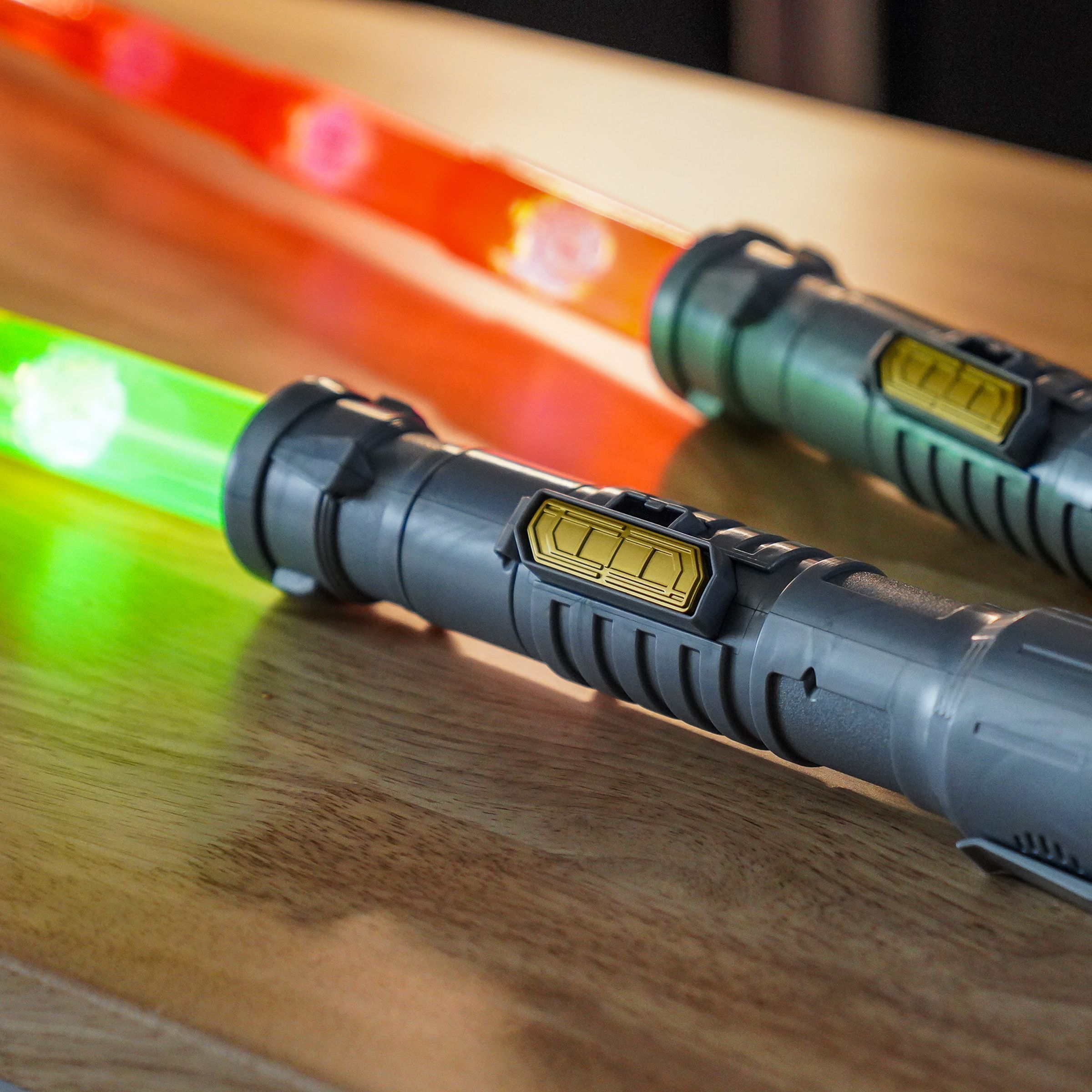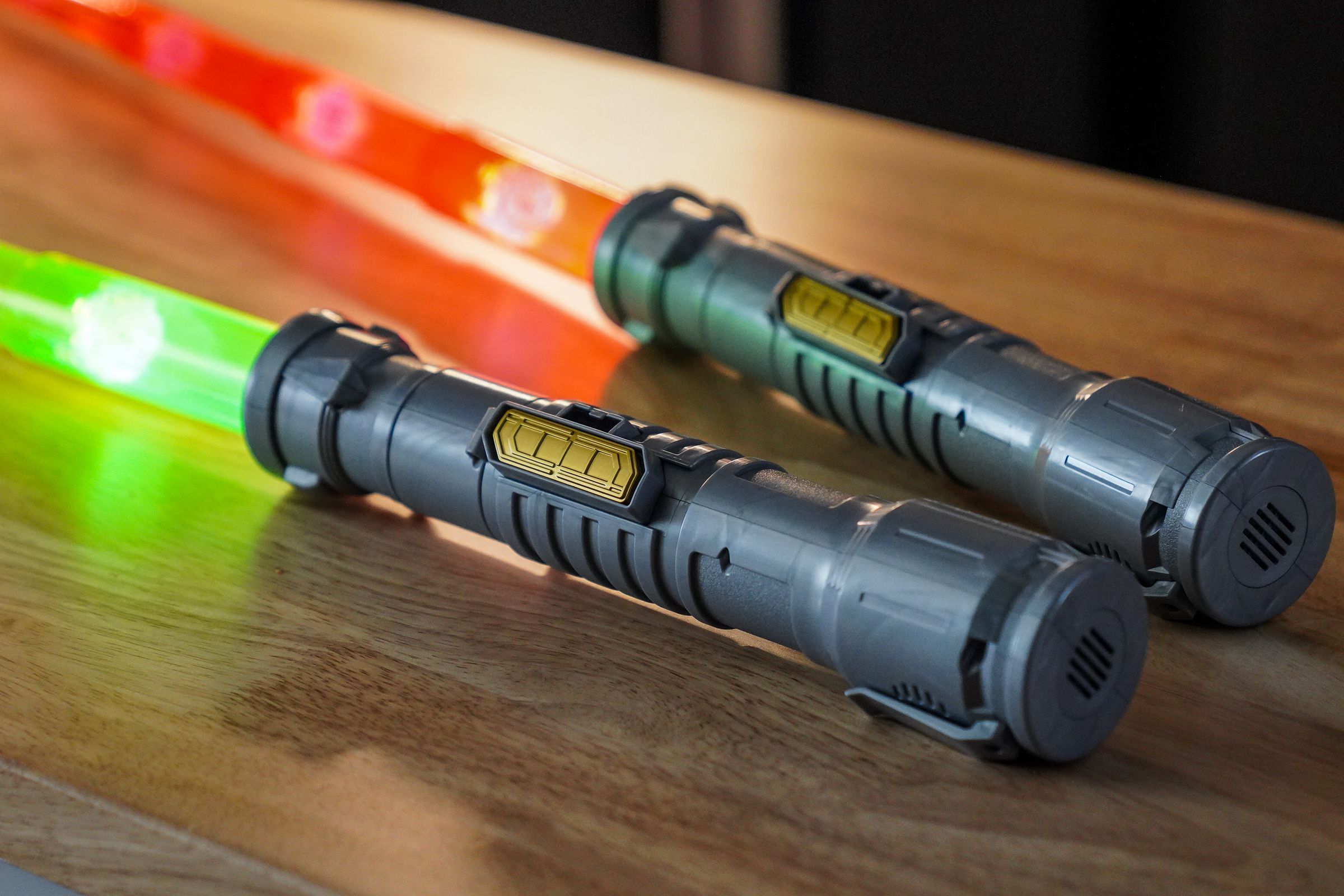Hasbro turned down the holy grail of lightsaber toys, and it won’t say why.
The Star Wars toymaker spent two years secretly working on a kids lightsaber that can automatically extend and retract its blade — the very first of its kind. Hasbro acquired all rights to the idea from a previously unknown Israeli inventor and patented it around the world.
But instead of finishing the product, Hasbro walked away without explanation. It let the inventor claw back the rights. Today, with the help of a different manufacturer, you can finally buy it at Amazon, Walmart, and Target— as the Goliath Power Saber.
The $60 toy doesn’t have official Star Wars sounds or authentic Jedi or Sith hilts. The blade isn’t as long as the movie sabers, and it doesn’t have the build quality or sophistication of pricier props.
But a simple yet ingenious mechanism means we finally have a lightsaber toy that can actually retract its own blade. Slide the golden switch, and a noisy motor sends each of its glowing blade segments smoothly in and out of the handle. Poke someone with the saber, and its blade will safely collapse without damage. You can even safely point it at your own face — see that in my video below.
Three years after Disney jazzed the world with a self-retracting lightsaber prop that you’ll never get to touch, one that was exclusively used by a paid actor in its shuttered $6,000-per-stay Star Wars hotel, you can now buy a toy that captures some of the same magic.
And its Israeli inventor claims that the Power Saber is just the start.
Yair Shilo tells The Verge it took five years just to figure out the right formula for a safely collapsing automatic blade, starting with prototypes made of paper and tin foil. He says he sold newspapers, trimmed lawns, and cleaned swimming pools while he worked on his Star Wars childhood dream, eventually rallying a cousin and an investment group behind a provisional patent in 2019.
Fundamentally, the new Power Saber isn’t that complicated inside. Just like the kiddie saber I proudly carried to the premiere of Star Wars: Episode I in 1999, the blade consists of telescoping tubes that stick together when fully extended. With those kiddie sabers, you flick your arm to propel the whole set of tubes; with the Power Saber, each segment is pushed upward and pulled downward by a long screw.
But that’s not the clever part. The simple genius of Shilo’s patent is that each blade segment isn’t married to that screw, so you can safely collapse them without sticking a screw into your hand. As the saber extends, each segment lifts up off the screw, carried into the air by the segment behind it. Once the tip of the saber extends far enough, it pulls the next blade segment up into the air, and the next, and the next, until they’re all fully extended, held together by friction alone.
And, each blade segment has flexible tabs where they meet the smooth screw, letting them slip down their track when you apply pressure. Even if you roughly shove the whole blade back into its casing — which I’ve done plenty of times in tests — it doesn’t hurt or damage the internal mechanism, claims Shilo.
That’s something its inventor says other designs never cracked. “99 percent of them, something needs to push the smallest segment from inside,” he says. “With this mechanism, nothing pushes it.” Hasbro tried for years, says Nextoy founder Robert Fuhrer, and it did create spring-loaded auto-extending blades, but there were always potential safety issues when auto-retracting a toy lightsaber’s blade. Shilo ran into some of them himself with an earlier model that relied on traditional gears.
The “biggest toy ever”?
But Shilo didn’t just want to build an auto-retractable blade; he wanted to build an official Star Wars lightsaber with Hasbro, the company with Disney’s exclusive blessing to mass-produce genuine Star Wars toys. “He was asking around the toy industry if anybody was tied up with Hasbro and knew them well,” recalls Fuhrer, who successfully connected him to the company and remains his agent today.
In 2020, Shilo shipped Hasbro a wooden wine box containing a white plastic prototype with a red motorized blade. He says Hasbro was more than happy — they told him he’d finally cracked the code. They told him it’d be the “biggest toy ever.”
Two years later, it fell apart.
“They say to us, hey bye bye, we’re not going to do it, we have a problem inside, we have a lot of things going on, you need to go,” says Shilo.
No one’s willing to tell The Verge what actually happened. Shilo, Fuhrer, even Power Saber manufacturer Goliath all suggest they want to maintain a positive relationship with Hasbro instead of speaking out of turn.
Hasbro won’t say, either. “We greatly value our partnerships with inventors who bring us their ideas for toys and games. For a variety of reasons, we were unable to move forward with this particular concept,” reads a statement from Hasbro senior publicity manager Whitney Spencer to The Verge.
Fuhrer strongly suggested I speak to Angus Walker, Hasbro’s head of inventor relations, but the company declined to make him available for an interview.
It makes me wonder: could there still be some fundamental issue with the design? (I did note that sometimes the saber’s tip falls in after a handful of whacks.) But Fuhrer says no, Hasbro didn’t cite any specific concerns. “There was no hard reason,” he says. “There was nothing like ‘there’s a safety issue’ or a cost issue or anything like that.”
He also downplays the possibility that Hasbro might sue over the patent. “I don’t think there’s any feeling of animosity,” says Fuhrer.
He speculates that Hasbro was just under a lot of pressure at the time. Hasbro CEO Brian Goldner had just died; it was the early pandemic; some projects fell by the wayside. Cost might have been a factor, too: he says Target and Walmart were pressuring toy companies to keep the price under $50. And, he says, an early prototype did fail one of Hasbro’s very early safety tests.
But he points to Goliath’s successfully shipping $60 saber at Target and Walmart as proof that neither cost nor safety were sticking points — and says Hasbro is going to regret missing out because the Power Saber will cannibalize their toy sales.
We were able to figure out why Hasbro would give the idea back to Shilo and his investors: Hasbro was contractually obligated to return the rights if it didn’t move forward, Fuhrer confirms. So they found a new partner in Goliath instead, a company previously mostly known for its board games, and the “Power Saber” was born.
I would’ve been blown away by this toy as a kid, but I wouldn’t have been completely satisfied by its knockoff feeling — and I gather Shilo might feel the same way. Earlier in our conversation, he’d spoken about the Star Wars lightsaber almost religiously, about how it’s “the only weapon that brings light to the world,” how he always wanted to be a Jedi, and how building a lightsaber was a childhood dream. How important is that official Star Wars part to him now, I ask?
He says that like the Force, he believes his lightsaber will eventually find his way to Star Wars. He says it’s meant to be.



Share this story